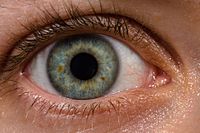
Photo from wikipedia
Eye movements serve vision in orienting gaze toward an object of interest in order to place its image simultaneously on both foveas and in stabilizing gaze relative to the environment… Click to show full abstract
Eye movements serve vision in orienting gaze toward an object of interest in order to place its image simultaneously on both foveas and in stabilizing gaze relative to the environment in order to maintain fixation on the object of interest, even in the case of body displacement. Disorders of eye movements can interfere with ocular alignment and/or monocular motility, and result in diplopia, which is the most common symptom. Eye movement disorders can also interfere with binocular motility without ocular misalignment and result in gaze palsy. Finally, disorders of eye movement can interfere with ocular stability during fixation or body displacement and result in oscillopsia, which is an illusion of an unstable visual world. A systematic examination of eye movements should be part of the neurological exam in order to detect asymptomatic manifestations that can help for the diagnosis of multiple neurological pathologies. In the case of eye movement disorders, the goals of the examination are to precisely characterize the disorder of motility, alignment, or stability, in order to finally localize anatomically the lesion among the peripheral ocular motor system or the more complex central eye movement neural network and suggest mechanisms and etiologies. In this review, we are describing the standard methods of ocular motor examination, including a “general” approach to any ocular motor assessment, and also the specific approaches to evaluating ocular misalignment, difficulty moving both eyes, and finally unstable gaze. This article will include practical tips on how to perform the tests most effectively or how to interpret the clinical signs elicited.
Journal Title: Neurological Sciences
Year Published: 2022
Link to full text (if available)
Share on Social Media: Sign Up to like & get
recommendations!